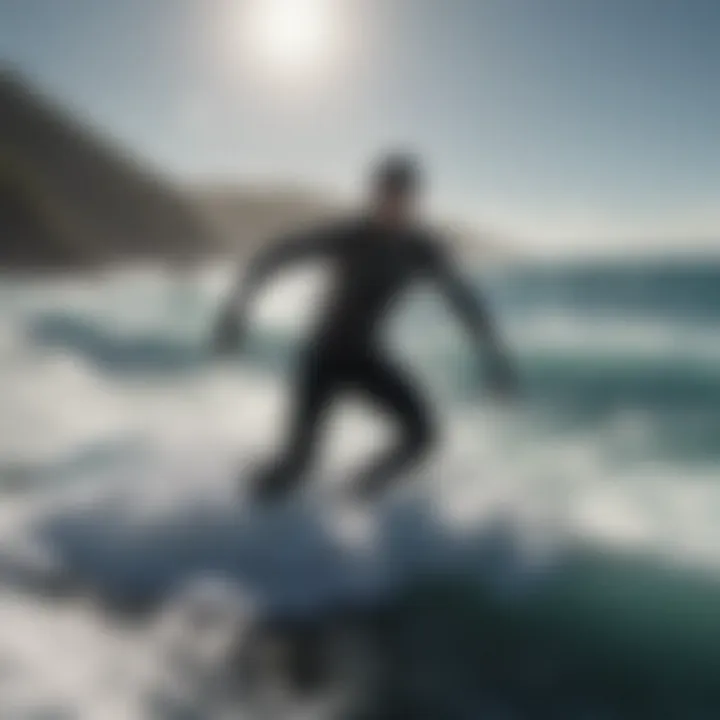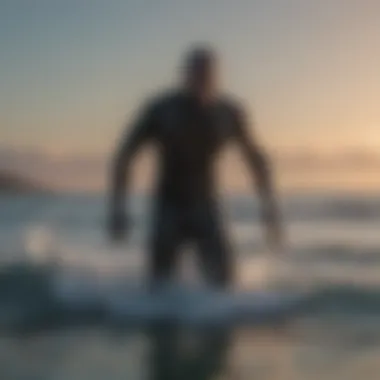Understanding the Fear of the Ocean: An Exploration


Intro
The ocean captivates and terrifies in equal measure. It is a vast expanse that holds both beauty and danger. For some, it is a source of adventure; for others, it evokes a profound sense of dread. This fear, known as thalassophobia, manifests in various ways, ranging from mild discomfort to profound anxiety. Understanding these fears is critical in order to not only address them but also to enjoy the thrilling experiences that the ocean can provide.
Exploring these fears requires examining the psychological foundations that contribute to them. Various factors, including personal experiences, cultural beliefs, and even evolutionary aspects, play a role in forming a person's perception of the ocean. While certain individuals are drawn to the water's edge, others find themselves paralyzed by its depth and unknowns. In recognizing the complex tapestry of thalassophobia, we can begin the journey toward overcoming it.
Discussing the tools and techniques designed to manage maritime anxiety can help individuals embrace activities like surfing, diving, or even swimming in the ocean. Additionally, this article aims to spotlight extreme sports enthusiasts who confront these fears head-on, showcasing how they integrate safety practices in their pursuits. Tools for understanding and managing one's anxieties become essential as we delve into the world of testing and evaluation of ocean-related fears, demonstrating that it is possible to navigate these waters with confidence.
Through insightful strategies and supportive communities, overcoming the fear of the ocean can be a fulfilling adventure. Those who decide to explore the depths of their anxieties often find a new sense of empowerment that accompanies their growth, transforming fear into respect and appreciation for the ocean.
By synthesizing testing methodologies and diving into the heart of thalassophobia, this exploration stands to benefit anyone interested in understanding their own limitations or encouraging others to embrace the ocean's wonders.
Foreword to Ocean Fears
The concept of fear related to the ocean has garnered significant attention, particularly as it intertwines with the experiences of thrill-seekers and extreme sports enthusiasts. This introduction serves as a gateway into understanding not just the defining characteristics of these fears, but also their implications on activities that occur on the water or near it. Gaining insight into ocean fears can aid individuals in confronting and overcoming these anxieties, which can hinder participation in activities like surfing, diving, or sailing. By contextualizing ocean fears, we can explore their psychological roots and the spectrum of responses they invoke.
Overview of Thalassophobia
Thalassophobia is the term used to describe the intense fear of the ocean or deep bodies of water. Unlike a general dislike for swimming or an aversion to marine life, thalassophobia is characterized by an overwhelming anxiety that can manifest in various situations, such as viewing the vastness of the ocean or entering unfamiliar waters. Many individuals may not realize they experience this phobia until they encounter specific scenarios that evoke a sense of dread. Research suggests that understanding thalassophobia requires a multidisciplinary approach, linking psychological theory with emotional responses.
Prevalence and Impact
The prevalence of thalassophobia is notable, with studies indicating that many individuals harbor some degree of fear related to the ocean. This fear can influence not just personal enjoyment of the seaside, but also broader social and economic factors associated with coastal activities. For instance, immediate societal impacts can be seen in tourism, where fear can deter individuals from participating in beach sports or marine experiences. Its effects can ripple into mental health, where untreated phobias may escalate to severe anxiety disorders. Understanding the impact of this fear paves the way for tailored interventions, fostering healthier relationships between individuals and the ocean.
The Psychological Basis of Fear
Understanding the psychological basis of fear is critical when addressing the nuances of ocean-related anxieties. The human mind is wired to respond to threats, and the ocean, with its vastness and unpredictability, often embodies this essence of fear. An exploration of this fear reveals its roots in both evolutionary biology and personal experiences. This section will focus on two primary theories: fear as a survival mechanism and conditioning and learning theories. Each theory offers valuable insights into how fear influences behavior, especially for those engaging with the ocean in adventurous ways.
Fear as a Survival Mechanism
Fear plays a crucial role in human survival. It activates instinctive reactions that prompt individuals to either confront or avoid potential dangers. In the context of the ocean, the vast, deep waters may induce feelings of vulnerability. This perception can lead to fear responses tailored to protect oneself. For instance, studies suggest that humans possess a natural apprehension towards depths, which can be traced back through generations of evolutionary history.
This survival instinct becomes particularly significant for thrill-seekers and extreme sports enthusiasts. While they yearn for adrenaline and excitement, the deep-seated survival instinct related to the ocean can simultaneously create barriers. As a result, some may avoid activities such as surfing or diving even if they are physically capable, purely due to these instinctual fears.
"The fear response is deeply embedded in our psyche, often overriding even our most adventurous intents."
Conditioning and Learning Theories
Conditioning and learning theories further explain why fears can take such strong hold in individuals. The principles of classical and operant conditioning can teach us how fear of the ocean may develop. For instance, if someone has had a negative experience, such as nearly drowning or witnessing a friend’s accident, this event can condition a lasting fear response. Each time the person approaches the ocean, the memory of that trauma may trigger anxiety and avoidance.
Additionally, observational learning, where individuals mimic the fearful responses of others, can also contribute to ocean-related fears. Children or young adults may become fearful if they see their parents or peers expressing anxiety around deep water or ocean creatures. This learned behavior can solidify a phobia that may persist into adulthood.
Understanding these psychological underpinnings allows individuals and professionals to use specific strategies to help overcome such fears. From fostering resilience through gradual exposure to cognitive behavioral techniques, there are pathways to managing one’s relationship with the ocean.
Types of Ocean-related Fears
Understanding the types of fears connected to the ocean is crucial, especially for thrill-seekers and extreme sports enthusiasts. Each of these fears can significantly impact one's experience and performance in aquatic activities. They shape one’s approach to challenges and can dictate whether an individual engages with the ocean or avoids it entirely. Recognizing these fears allows for targeted strategies to manage them, potentially leading to greater enjoyment and participation in water sports.
Fear of Depths
The fear of depths, often referred to as bathophobia, is a prominent concern among individuals facing ocean-related anxieties. This fear generally manifests as a dread of being submerged in deep water where the unknown lurks beneath. It is often linked to a fundamental human instinct to fear environments that are unpredictable and outside of one’s control.
Persons suffering from this fear may experience acute anxiety when swimming in the open sea or participating in activities like diving. This anxiety can manifest in physiological symptoms such as increased heart rate, shortness of breath, or even panic attacks. Understanding this fear is essential, as it highlights the psychological barriers that might prevent individuals from even trying water sports that they would otherwise enjoy.


Fear of Creatures
Another significant ocean-related fear is the fear of creatures. This can encompass a wide range of concerns, from the fear of sharks to more general anxieties about all marine life. This fear is particularly intense due to the portrayal of ocean creatures in media, which often emphasizes danger and unpredictability.
This fear can severely limit one's willingness to engage with the ocean. Many thrill-seekers find that their participation in activities like snorkeling or diving is hampered by their anxiety over potential encounters with marine creatures. The fear of creatures is often rooted in a lack of understanding or exposure. By educating oneself about the various species in the ocean and recognizing that most marine creatures do not pose a threat, individuals can start to mitigate this fear.
Navigational Fears
Navigational fears are another layer to ocean-related anxieties. These fears often arise from concerns about losing one's way, particularly in unfamiliar waters. The ocean's vastness can instill a sense of disorientation, which can be particularly alarming for individuals unaccustomed to aquatic environments.
When surfing, sailing, or engaging in any water-based sport, the ability to navigate effectively is crucial. Encountering new currents or variable weather conditions can heighten a person's stress levels, making them reluctant to explore further. Understanding and addressing navigational fears is important for safety and enjoyment. Engaging in preparatory training and practicing navigation techniques can significantly reduce anxiety in these situations and foster confidence in managing the unknown expanses of the ocean.
Testing the Fear of the Ocean
Understanding the fear associated with the ocean involves assessing feelings, thoughts, and experiences. Testing the fear of the ocean is a critical aspect of addressing thalassophobia. By utilizing various methods and tools, individuals can explore the depth of their fears, which is essential for personal growth and overcoming these anxieties. Such assessments provide valuable insights into the mechanisms of fear, helping to distinguish between manageable anxiety and debilitating phobia. As we dive deeper into this subject, we will discuss specific testing methodologies that can aid in comprehensively understanding and tackling ocean-related fears.
Standardized Psychological Tests
Standardized psychological tests serve as a foundation for evaluating thalassophobia. These tests are designed to assess an individual's specific fears in a consistent manner. Instruments such as the Fear of Water Scale and other related psychological assessments help identify the severity of fear regarding the ocean.
These tests usually comprise questions that relate to feelings, thoughts, and behavioral responses associated with ocean experiences. Scoring these tests allows mental health professionals to gauge the level of fear, which can inform treatment options. Testing is advantageous as it provides a structured approach to understanding anxiety, paving the way for a tailored intervention that suits personal circumstances.
Self-Assessment Tools
Self-assessment tools also play a vital role in evaluating fear of the ocean. Individuals can utilize questionnaires and rating scales at their own pace. These tools encourage introspection and self-awareness, which are critical in the journey towards overcoming fear. Examples include the Ocean Fear Inventory, where respondents rate their fear levels associated with various ocean scenarios.
These assessments can reveal patterns and triggers, contributing to self-knowledge. Moreover, they are accessible to anyone, making them a practical option for those reluctant to seek professional help. While self-assessments are useful, they should be complemented with professional guidance for a well-rounded understanding and strategy for managing fears.
Experimental Exposure Methods
Experimental exposure methods are geared toward gradually confronting fear. This technique, often informed by principles of behavioral therapy, aims to desensitize individuals to their fear of the ocean. Examples include virtual reality simulations or controlled exposure to ocean environments under safe circumstances.
In practical terms, the process may involve starting with imagery of the ocean, progressing to viewing it in person, or even participating in low-pressure water activities. The key is a gradual increase in exposure, allowing individuals to acclimate to their fears systematically. Such methods are backed by research and can yield significant benefits in reducing anxiety, ultimately fostering a healthier relationship with the ocean.
"Facing fear can lead to powerful transformations, turning anxiety into adventure."
Testing the fear of the ocean through these diverse methodologies is not merely about confronting an emotion. It encompasses a broader journey of understanding oneself and building resilience. Through psychological tests, self-assessment, and gradual exposure, individuals can take meaningful steps toward conquering their ocean-related fears.'
Implications for Extreme Sports Enthusiasts
The topic of ocean-related fears holds significant relevance for extreme sports enthusiasts. This unique blend of excitement and apprehension can deeply influence how individuals approach activities such as surfing, scuba diving, and other ocean sports. Understanding these fears is crucial, as it allows adventurers to enjoy the thrill of the ocean while managing their anxieties effectively.
Daring to Surf: Challenges and Fears
Surfing, a quintessential extreme sport that takes place in the ocean, presents a multitude of challenges that can evoke fear. One of the primary concerns is the fear of big waves, which can intimidate even seasoned surfers. The unpredictability of ocean conditions adds to this anxiety, making some enthusiasts hesitant to take the plunge.
Fear of marine life also plays a role. Encounters with jellyfish, sharks, or even simple fish can provoke anxiety in surfers. These fears may stem from prior negative experiences or stories from others. However, recognizing and addressing these fears is essential. It is important for surfers to develop strategies that allow them to face these challenges head-on, transforming fear into motivation rather than a deterrent.
Safety Techniques and Gear
Safety is paramount in ocean sports. Implementing proper techniques and using the right gear can greatly reduce risk and anxiety.
- Life Jackets: Wearing a personal flotation device consistently is essential for safety. This can provide a sense of security, especially for those who have a fear of deep water.
- Wetsuits: A wetsuit not only helps to regulate body temperature but also provides comfort and confidence in the water.
- Buddy System: Surfing or participating in ocean sports with a partner can offer emotional support. A buddy can help in case of emergencies and also help alleviate some of the fears associated with being in the ocean.
- Training: Participating in safety courses can also boost confidence. Learning rescue techniques and ocean safety increases both safety and knowledge, helping to confront fears directly.
These techniques and tools should be a priority for anyone engaging in ocean activities, as they provide a solid foundation for building confidence and minimizing fears.


Community and Support Networks
Engaging with a supportive community is invaluable for extreme sports enthusiasts. Finding like-minded individuals who share similar passions can help individuals remediate their fears.
- Local Surf Clubs: Joining local surf clubs can provide camaraderie and support. Sharing experiences with fellow surfers might help ease anxiety.
- Online Forums: Platforms like Reddit offer spaces where surfers can discuss fears and share coping strategies. This can make individuals feel less isolated in their experiences.
- Workshops and Clinics: Participating in training clinics allows amateurs to learn from experienced professionals. Community-led workshops facilitate personal growth and foster a positive environment for discussing ocean fears.
Ultimately, the journey of confronting fears within the ocean sports community becomes a collective experience. By navigating through fears together, enthusiasts can empower one another to embrace the thrill of the ocean sustainably and responsibly.
Understanding the psychology of ocean fears is essential for transforming anxiety into passion, enabling extreme sports enthusiasts to face the waves with confidence.
Methods for Overcoming Ocean Fear
Understanding and addressing the fear of the ocean is essential for anyone looking to engage with the sea, whether for leisure or extreme sports. Overcoming such fears not only enhances the enjoyment of these activities but also promotes mental well-being. In this section, we will delve into several effective methods that can be employed to reduce and manage thalassophobia. By integrating cognitive behavioral strategies, gradual exposure techniques, and mindfulness practices, individuals can cultivate a healthier relationship with the ocean.
Cognitive Behavioral Strategies
Cognitive-behavioral approaches serve as one of the most effective treatments for phobias, including those related to the ocean. This method focuses on the interplay between thoughts, feelings, and behaviors. By identifying and challenging irrational beliefs about the ocean, individuals can begin to reshape their perceptions. For instance, a person who fears drowning may hold onto catastrophic thoughts.
The benefits of this approach include:
- Reduced Anxiety: As individuals learn to reframe their thoughts, their overall anxiety levels diminish.
- Improved Coping Skills: Strategies learned through cognitive-behavioral techniques provide tools for understanding and managing fear in various scenarios.
- Long-Lasting Change: By addressing the root thoughts, the change in perspective can be lasting, benefiting other areas of life.
Notably, professionals often employ techniques such as thought records and exposure tasks, which can help break the cycle of fear and avoidance.
Gradual Exposure Techniques
Gradual exposure techniques focus on slowly and systematically introducing individuals to the source of their fear. This method aims to desensitize the fear response over time. By starting with less anxiety-provoking situations related to the ocean, individuals can build confidence before facing more significant challenges.
Consider the following steps for a gradual exposure plan:
- Imaginary Exposure: Start with visualizing being by the ocean or engaging in ocean activities.
- Watching Videos: Progress to watching videos of the ocean, allowing for a safe distance.
- Physical Proximity: Visit the beach without entering the water to become accustomed to the environment.
- Wading and Swimming: Finally, gradually entering the water when comfortable.
The overall effect of gradual exposure is a decreasing fear response and an increasing sense of mastery over the situation. This method requires patience and commitment, but it leads to substantial decreases in fear over time.
Mindfulness and Relaxation Practices
Mindfulness and relaxation techniques play a vital role in managing anxiety and fear. These practices help individuals stay present and centered, reducing the overwhelming nature of fear. Techniques like deep breathing, meditation, and yoga can enhance mental resilience.
Key components of mindfulness practices include:
- Focused Breathing: Concentrating on the breath helps anchor the mind and reduces racing thoughts.
- Body Scan: This technique encourages awareness of the body, identifying areas of tension related to fear.
- Visualization: Imagining peaceful ocean scenes can promote relaxation while fostering a positive association with the ocean.
- Regular Practice: Consistent practice of mindfulness cultivates a state of calm and enhances emotional regulation.
Engaging in mindfulness not only aids in fear management but also fosters a deeper appreciation for the ocean.
"Mindfulness is the art of being present and aware, even amidst the storm of anxiety."
Success Stories and Case Studies
Success stories and case studies play a pivotal role in understanding and managing the fear of the ocean. These narratives offer a window into the lived experiences of individuals who have faced and conquered their fears. The importance of these accounts cannot be overstated. They provide hope and practical insights for others grappling with similar anxieties. Moreover, these stories often highlight the diverse paths one can take in overcoming thalassophobia, whether through therapy, self-exploration, or community support.
Personal anecdotes can act as powerful motivators. Readers may find common ground with those who have faced overwhelming fear yet emerged resilient. The emotional weight of a narrative can resonate deeply, creating an empathetic connection. This section aims to illuminate the transformative journeys of individuals who have moved from a state of fear to one of confidence, particularly in ocean-related activities. By understanding these instances, thrill-seekers and extreme sports enthusiasts can glean valuable lessons applicable to their own experiences.
Personal Narratives of Conquering Fear


The journeys of individuals who have successfully confronted their fears of the ocean reveal both struggle and triumph. Many of these personal narratives illustrate the gradual process involved in overcoming thalassophobia. For example, one account details how a surfer, once paralyzed by the thought of deep waters, took small steps towards recovery. Starting with shallow water experiences, the individual gradually learned to trust their skills and the ocean itself. Each success reinforced their confidence, enabling them to ultimately ride larger waves.
In another compelling story, an individual described taking diving lessons despite an intense fear of underwater creatures. Through consistent exposure and the guidance of experienced instructors, the fear was not erased but managed. The transformative journey illustrates how repeated exposure can help dismantle the barriers created by fear.
These personal narratives often underscore key strategies that can be adopted by others. Setting achievable goals, leaning on community support, and actively engaging with one’s fears in a controlled manner are common themes. Furthermore, individuals frequently emphasize the importance of perseverance and patience in their journeys.
Professional Guidance Outcomes
Engaging with professionals, such as psychologists or qualified instructors, offers another layer of support in conquering fears related to the ocean. The role of professional guidance is crucial in shaping positive outcomes. Many individuals seeking to overcome thalassophobia benefit significantly from structured programs that utilize cognitive behavioral strategies. These approaches facilitate a better understanding of one’s fears and provide tools for coping.
In case studies involving professional assistance, individuals have reported enhanced feelings of safety and confidence. For example, one study highlighted the effectiveness of therapy that combines visualizations of ocean scenarios with live exposure. Participants initially focused on calm imagery, gradually transitioning to real-life environments under professional supervision. This blend of theory and practice yielded remarkable results, with many individuals experiencing a significant reduction in anxiety.
Additionally, instructors in extreme sports have crafted specialized courses that address ocean fear directly. These programs often include safety techniques, equipment familiarization, and gradual exposure to challenging environments. The outcomes frequently reflect not only improvements in skills but also remarkable shifts in mindset, allowing individuals to embrace activities once deemed unattainable.
"With time, support, and the right strategies, fear can transform into a source of strength rather than a barrier."
In summary, success stories and professional guidance are critical components in navigating the journey of overcoming ocean-related fears. Through personal narratives, readers can draw inspiration and understand the processes involved in transforming fear into empowerment.
Future Directions in Fear Research
The exploration of fear, particularly in relation to the ocean, remains an evolving field of study. As individuals continue to confront their primal instincts against vast waters, understanding how these fears develop can lead to more effective coping mechanisms and interventions. This section emphasizes the importance of future research directions that can reveal insights into thalassophobia and similar anxieties.
Identifying these directions allows researchers to uncover the underlying causes of ocean fear, paving the way for innovative approaches. The focus on fear research serves not just the academic community but also practitioners in mental health, educators in adventure sports, and everyday individuals wanting to understand their fears more effectively.
Evolving Perspectives on Ocean Fear
In recent years, the acknowledgment of diverse perspectives on ocean fear has gained traction. Traditionally, many viewed thalassophobia simply as an irrational fear. However, contemporary research is starting to uncover its deeper roots in human biology and psychology.
Factors influencing these evolving perspectives include:
- Cultural Context: Different cultures have varied relationships with the ocean, influencing collective fears and responses.
- Personal Experiences: Individual histories, such as a traumatic boating incident, can shape one's perception of the ocean.
- Environmental Changes: Climate change and increased natural disasters have raised awareness and apprehension about water safety.
Recognizing these dynamics can lead to a more nuanced understanding of the fears associated with the ocean. It also has practical implications for those involved in extreme sports, allowing them to approach these anxieties with empathy and awareness.
Research Opportunities and Innovations
The landscape of fear research is ripe for exploration and innovation. As technology advances, new methodologies open doors for studying thalassophobia in ways that were not previously possible. Some notable opportunities include:
- Virtual Reality Simulations: These can provide controlled environments for exposure therapy, helping individuals confront their fears in a safe manner.
- Neuroscientific Techniques: Brain imaging can reveal how fear responses are processed and managed at a neural level, informing treatment approaches.
- Community-driven Research: Engaging with those who experience thalassophobia can yield insights through participatory research, ensuring that studies reflect real-world experiences.
In summary, advancing our understanding of fear through innovative and multifaceted research approaches can lead to effective treatments and enhanced safety protocols for ocean-related activities. Engaging with these directions not only helps individuals manage their fears but also enriches the collective knowledge surrounding human-animal interactions with vast bodies of water.
Closure
The exploration of ocean-related fears, particularly thalassophobia, provides significant insights into both psychological mechanisms and practical approaches for overcoming them. Understanding the complexities of this fear is essential not only for individuals who experience it but also for instructors and mentors within extreme sports communities. Addressing such fears can lead to greater confidence and improved enjoyment of ocean activities.
Summarizing Key Points
In this article, we covered numerous essential aspects about ocean fear:
- Definition and Nature of Thalassophobia: Understanding its emotional roots helps contextualize why people fear the ocean.
- Psychological Theories: Fear functions not merely as an emotional response but as a potential survival mechanism rooted in our evolutionary past.
- Various Types of Ocean Fears: The range of fears varies widely, from fear of depths to fear of specific creatures, highlighting individual differences.
- Testing and Measurement: Effective methods such as standardized psychological tests and self-assessment tools provide clarity on the intensity and trigger of these fears.
- Strategies for Individuals: Cognitive behavioral strategies and gradual exposure techniques are vital tools for anyone aiming to confront their fears.
- Community Support: Displaying how extreme sports enthusiasts can benefit from sharing experiences, as well as professional guidance, demonstrates the role of social contexts in overcoming fear.
These points collectively underline the significance of understanding and addressing the fear of the ocean, reinforcing its relevance to both personal growth and community engagement.
Encouraging Engagement with the Ocean
Fostering a positive relationship with the ocean is crucial. Fear should not stifle one's enthusiasm for exploration. Instead, adopting strategies to manage these fears can enhance the experience of engaging with this vast, natural environment.
- Participate in Education Programs: Knowledge about marine environments often diminishes fear. Workshops about oceanography or marine safety can be beneficial.
- Join Local Ocean Clubs or Groups: Connecting with like-minded individuals can ease fears through shared experiences.
- Start Slow: For those terrified by the ocean, beginning with calm waters or shallow areas can build confidence.
- Seek Gainful Experiences: Engaging in sports like kayaking or paddleboarding can be rewarding, as such activities offer control combined with the thrill of being on the water.
- Mindfulness Practices: Developing mindfulness techniques can help manage anxiety and result in a calmer approach to ocean engagement.
By gradually summoning courage and curiosity, those with ocean fears might find not only enjoyment but a newfound appreciation of nature’s power.







